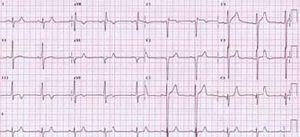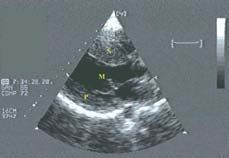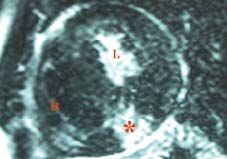Figure 1.
Figure 2.
Figure 3.
Myocardial Fibrosis in Hypertrophic Cardiomyopathy
A 20-year-old man was referred to our myocardial disease unit for family screening. His father presented obstructive hypertrophic cardiomyopathy and had an automatic defibrillator implanted for sustained ventricular tachycardia. His brother had died of sudden death at the age of 12.
The patient only reported dyspnea on exertion. In the electrocardiogram (ECG) there were signs of left ventricular enlargement with Q waves in V1-2 and V6, and repolarization alterations (Figure 1). Echocardiography showed thickening (26 mm in the septum [S] and 21 mm in the posterior wall [P]), anterior systolic mitral motion [M] (Figure 2), and an obstructive outflow tract gradient of 91 mm Hg, with grade 2 mitral regurgitation. A stress test was performed without treatment and discontinued at 2.55 min, observing a hypotensive arterial response. The Holter-ECG showed no alterations.
Magnetic resonance imaging revealed severe concentric left ventricular hypertrophy and areas of delayed enhancement after gadolinium administration, suggestive of areas of fibrosis (Figure 3, asterisk).
Since the patient had risk factors associated with sudden death (history of sudden death in a family member, obstructive subaortic gradient and hypotensive response to exercise), a defibrillator was implanted for primary prevention of sudden death.
Recent studies have indicated that areas of enhancement within hypertrophic areas correspond to alterations in the volume and composition of the extracellular matrix, and can have a patchy or homogeneous pattern. In contrast to the typical fibrosis produced by ischemic heart disease, however, it does not follow the centrifugal distribution of subendocardium to subepicardium or that of a coronary artery. In addition, this finding is related with a poorer prognosis.






